1. Early life and background
Sun Myung Moon's formative years were shaped by his family's religious conversion and the tumultuous political landscape of Korea under Japanese rule, which influenced his early activities and ideological development.
1.1. Birth and family background
Moon was born as Mun Yong-myeong on 25 February 1920 in Sangsa-ri, Deogun-myun, Jeongju-gun, North P'yŏng'an Province, Korea, which is now Jeongju, North Korea. He was the second son among thirteen children in a farming family of the Nampyeong Mun clan, though only eight of his siblings survived. His family initially adhered to Confucianism but converted to Presbyterianism when Moon was around 10 years old. His granduncle, Moon Yun-guk, a Presbyterian pastor and graduate of Pyongyang Theological Seminary, was a key leader in the March 1st Movement for Korean independence in North Pyongan Province, leading protests from Osan School. Moon Yun-guk's activities led to his imprisonment and the family's financial ruin due to their support for the Korean Provisional Government.
1.2. Education and early activities
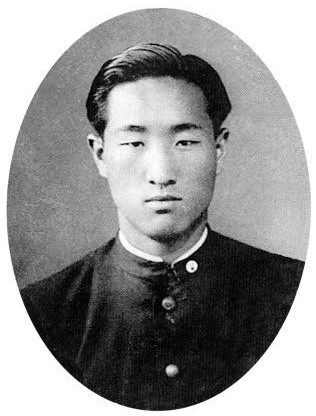
In 1938, Moon attended Gyeongseong Commercial and Industrial School in Seoul, where he studied electrical engineering. During this period, he was also active as a Sunday school teacher at the Myeongsu-dae Chapel, a mystical new religious movement. He engaged in missionary work around Changgyeongwon, Heukseok-dong, and Sangdo-dong. In 1941, he traveled to Japan to study electrical engineering at Waseda University's Higher Technical School, residing in Totsuka-cho, Yodobashi-ku (now Nishi-Waseda, Shinjuku). While in Japan, he adopted the Japanese name "Emoto Ryumei." He worked odd jobs, including carrying coal at shipyards and in the transportation industry. During his time in Japan, he organized a secret society of Korean students and engaged in anti-Japanese independence activities, collaborating with Kim Ku of the Korean Provisional Government in Chongqing and with some Communist Party members in the Korean independence movement. He was monitored by the police, called in for questioning monthly, and even imprisoned. Moon claimed to have transported documents by clinging to the underside of trains from Busan to Andong for the provisional government. He also visited red-light districts, claiming it was to understand the suffering of women forced into such lives.
After graduating in October 1943, Moon returned to Seoul and in March 1944, he began working as an electrical engineer at the Gyeongseong branch of Kajima Gumi. In October 1944, his anti-Japanese activities in Japan were discovered, leading to his arrest and severe torture by the Gyeonggi Provincial Police Department. He was released in February 1945 but continued to suffer from the effects of torture. In October 1945, he was briefly detained for a week due to a financial dispute. From late 1945 to April 1946, he studied under Pastor Kim Baek-moon at the Israel Monastery, a new religious movement considered heretical by mainstream Christianity. Moon claimed that Kim Baek-moon blessed him to receive the glory of King Solomon. However, some scholars suggest Moon's doctrines, including "creation, fall, and restoration," were influenced by Kim Baek-moon's earlier established teachings.
Moon claimed to have experienced a profound religious vision of Jesus on Easter morning, 17 April 1935, at age 16, while praying on a small mountain. He stated that Jesus asked him to complete his unfinished mission to save all humanity. Though he initially refused due to the immense responsibility, he eventually accepted. He further claimed to receive additional revelations through prayer and Bible study.
2. Founding of the Unification Church and Theology
Sun Myung Moon established the Unification Church with core theological tenets outlined in the Divine Principle, asserting his own messianic status and that of his wife as "True Parents."
2.1. Establishment in Korea
In May 1946, Moon traveled alone to Pyongyang, then under Soviet occupation, leaving his family in South Korea, to seek out spiritual churches. Pyongyang was a center of Christian activity until 1945, but faced increasing persecution under the Soviet-controlled North Korean government. He began preaching and gathering followers, holding meetings at the home of a female believer, Kim Jeong-hwa, and also met Jeong Deuk-eun. The group was known as the "Crying Church" because Moon and his followers often wept during prayers, expressing God's sorrow. Services were conducted in white attire, with repeated hymns creating a spiritual atmosphere, and many members claimed to receive divine revelations in dreams.
Due to the North Korean government's crackdown on new religions, Moon was investigated for fraud and espionage in June 1946. Although the espionage charges were not substantiated, he was imprisoned for disturbing social order from August to November 1946. After his release, his following grew, but he was re-arrested in February 1948 on charges of disturbing social order and imprisoned in Pyongyang. During this period, he faced allegations, which the Unification Church denies and some scholars have doubted, of unorthodox sexual rituals, sometimes referred to as P'ikareum, and polygamy, which contributed to some of his arrests. In May, he was transferred to the Hungnam labor camp for a five-year sentence, where prisoners were routinely forced to work to death on meager rations. Moon claimed divine protection for his survival, noting his habit of saving half his water ration to wash off hazardous chemicals after handling fertilizer with bare hands.
In October 1950, during the Korean War, he was liberated by UN troops who reached Hungnam. He then traveled on foot to Busan, South Korea, reuniting with some disciples, including Mun Jeong-bin, Park Jeong-hwa, Ji Seung-do, Ok Se-hyeon, and Kim Won-pil. After a brief imprisonment in Busan on suspicion of forgery (which was later overturned), he settled in a makeshift hut in Beomil-dong, which later became a holy site for the church. He worked as a port laborer until 1955. During this period, he began writing his core doctrinal text, the Original Principle, completing it in 1952.
On 1 May 1954, Moon formally founded the Holy Spirit Association for the Unification of World Christianity, commonly known as the Unification Church, in Seoul. The church quickly attracted young acolytes who helped build the foundations of Unification-affiliated business and cultural organizations. Early followers included Ji Seung-do, Ok Se-hyeon, Kim Won-pil, Lee Gi-wan, and Kang Hyeon-sil. He also established Tongil Industry in 1959, marking the beginning of his economic ventures. However, the church faced early persecution; in 1955, five faculty members and fourteen students from Ewha Womans University and Yonsei University were dismissed or expelled for their involvement with the Unification Church. Moon was also arrested on charges of illegal confinement and draft evasion, though these charges were later overturned. His first wife, Choi Sun-kil, publicly criticized the Unification Church and Moon during his imprisonment, eventually divorcing him.
2.2. Core doctrines and theology
The fundamental theological principles of the Unification Church are primarily laid out in the Divine Principle, or Exposition of the Divine Principle (원리강론Wolli GangnonKorean), co-written by Moon and early disciple Hyo Won Eu and first published in 1966. This text is considered scripture by believers and outlines concepts such as God's purpose in creating human beings, the Fall of Man, and restoration-the historical process through which God works to reverse the effects of the Fall and restore humanity to its original intended relationship with God.
God is viewed as the creator, possessing both masculine and feminine attributes, and is the source of all truth, beauty, and goodness. Human beings and the universe are believed to reflect God's personality, nature, and purpose. Key interpretive concepts include "give-and-take action" (reciprocal interaction) and "subject and object position" (initiator and responder), with humanity designed to be God's object. The ultimate purpose of human existence is to bring joy to God. The "four-position foundation" (Origin, Subject, Object, and Union) is another crucial concept that underscores the emphasis on the family within Unification theology.
Moon claimed that when he was 16, Jesus appeared to him, anointing him to complete Jesus' unfinished work by becoming a "True Parent" to all of humanity. Unification Church members believe Moon and Hak Ja Han are the "True Parents" who would establish a "true family" untouched by Satan, thereby initiating humanity's liberation from its sinful condition. They teach that Jesus, though divine, was not God and was meant to be the second Adam who would create a perfect family. When Jesus was crucified before marrying, he redeemed mankind spiritually but not physically. This physical redemption was left to the "True Parents"-Moon and Han-who would connect married couples and their families to God. After his prison sentence in 1984, Moon began calling himself humanity's Messiah and officially conferred the title upon himself in 1992.
3. Marriage and family life
Sun Myung Moon's personal relationships, especially his marriages, were central to the Unification movement's theology, with his family serving as the "True Family" and his union with Hak Ja Han as the "True Parents."
3.1. First marriage
Moon married his first wife, Choi Sun-kil (최선길Choe Seon-gilKorean), in May 1944. Choi Sun-kil was from the Reconstruction Church and had not participated in Shinto shrine worship during the Japanese occupation. They had a son, Sung Jin Moon (문성진Mun Seong-jinKorean), born in 1946. Their marriage ended in divorce in 1957, following years of separation and conflict arising from Moon's religious mission and his wife's public opposition to the Unification Church.
3.2. Marriage to Hak Ja Han
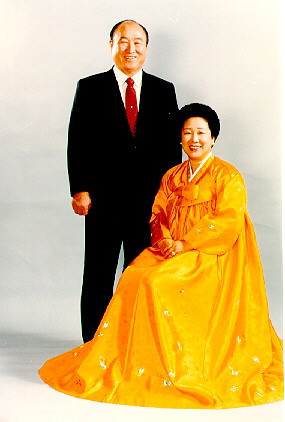
Moon married his second wife, Hak Ja Han (한학자Han Hak-jaKorean), on 11 April 1960, in a ceremony called the Holy Marriage. Han, who was 17 at the time, is referred to as "Mother" or "True Mother" by followers. Together, she and Moon are known as the "True Parents," and their family is called the "True Family." Hak Ja Han bore 14 children, though their second daughter died in infancy.
3.3. Blessing ceremonies
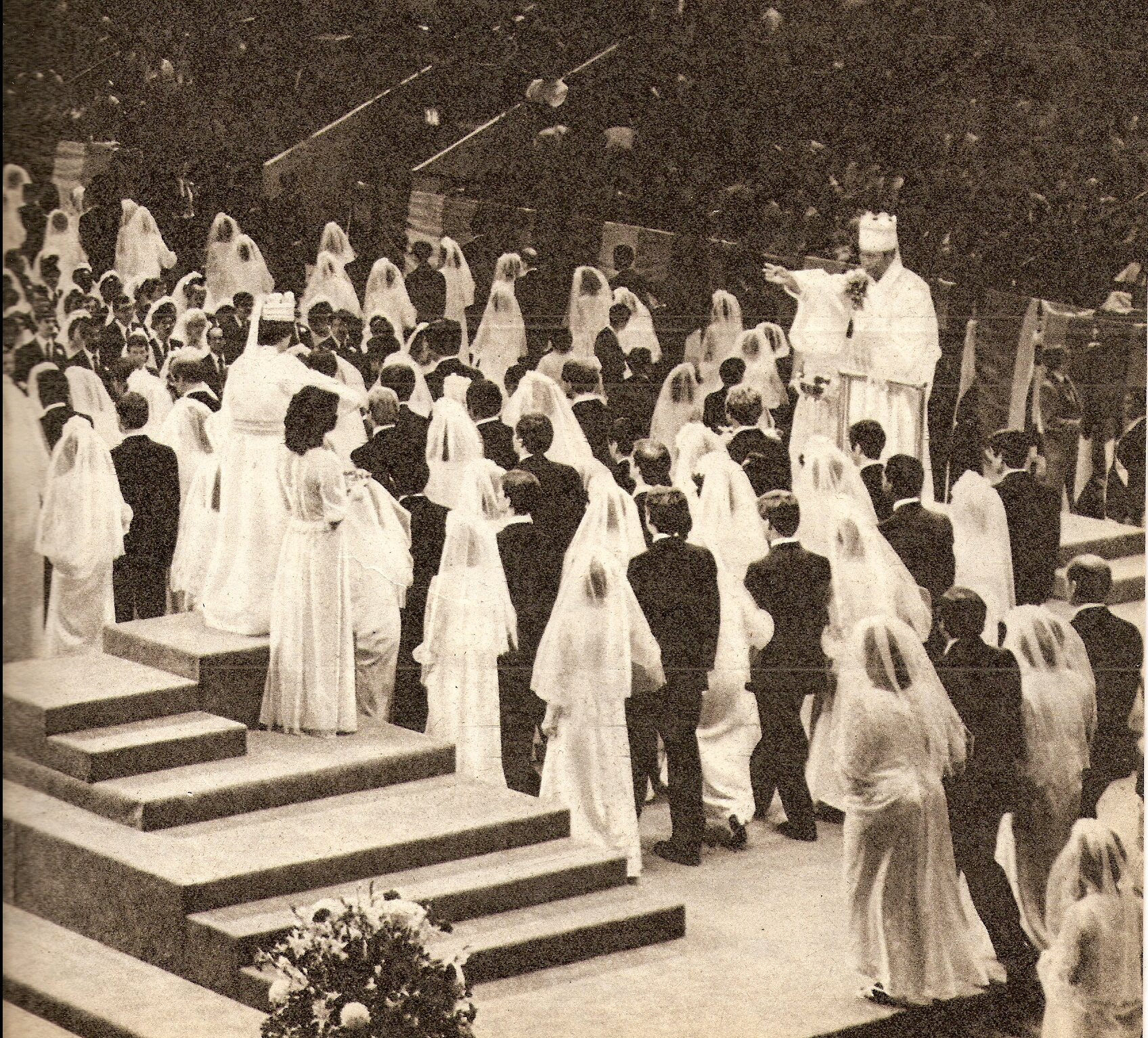
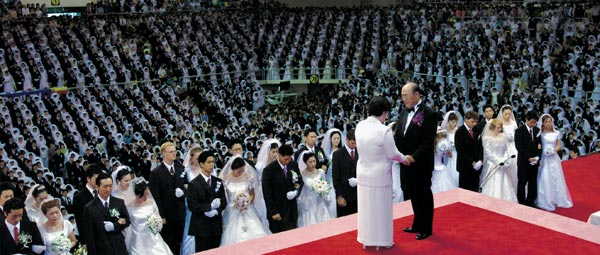
The Unification Church's signature mass wedding ceremonies, known as Blessing ceremonies, are a central practice. While early followers lived communally, Moon eventually emphasized traditional Christian family monogamy. These ceremonies have garnered significant public and media attention, often referred to as "mass weddings." In these ceremonies, Moon would "match" individuals, sometimes strangers from different countries, believing his decisions were divinely guided to unite humanity. Couples often had long engagements, getting to know each other through letters, and many were matched across racial and national lines to promote global unity. Public mass blessing ceremonies followed, with legal marriages conducted later according to the laws of each country. Some critics claimed that newly-wed couples were forbidden to sleep together for 40 days and that sexual positions were stipulated by Moon. Moon stated that "International and intercultural marriages are the quickest way to bring about an ideal world of peace. People should marry across national and cultural boundaries with people from countries they consider to be their enemies so that the world of peace can come that much more quickly."
The first Blessing ceremony involved 36 couples in Seoul in 1961. The scale of these events grew dramatically: over 2,000 couples participated in the 1982 ceremony at New York's Madison Square Garden, the first outside South Korea. In 1992, approximately 30,000 couples took part, and a record 360,000 couples participated in Seoul three years later. In February 2010, an additional 7,000 couples participated in a ceremony in South Korea presided over by Moon. These ceremonies, intended to highlight the church's emphasis on traditional morality, brought Moon both fame and controversy.
3.4. Children and succession issues
Moon had 15 children with Hak Ja Han, though one daughter died in infancy. His children were expected to assume leadership roles within the Unification movement and its associated businesses.
- Moon Ye Jin** (문예진Mun Ye-jinKorean, born 1960), eldest daughter, divorced from her blessed spouse.
- Moon Hyo Jin** (문효진Mun Hyo-jinKorean, 1962-2008), eldest son, was initially expected to be a successor. He became the first president of the World CARP (Collegiate Association for the Research of Principles) at age 21. However, he struggled with alcohol and drug addiction, and his marriage to Nansook Hong ended in divorce in 1997 due to his misconduct and alleged domestic violence. He later remarried Choi Yeon-ah and had five children. He was also a musician, composing heavy metal music, and produced documentary films and music albums.
- Moon Hye Jin** (문혜진Mun Hye-jinKorean, born 1963), second daughter, died shortly after birth.
- In Jin Moon** (문인진Mun In-jinKorean, born 1965), third daughter, served as the president of the Unification Church of the United States from 2008. She resigned in 2012 following her own divorce and remarriage, and now leads an online community called I-Home Church.
- Moon Heung Jin** (문흥진Mun Heung-jinKorean, 1966-1984), second son, died at age 17 in a car accident in New York in December 1983. A month after his death, Moon arranged a "spiritual marriage" between Heung Jin and Julia Moon (Mun Hun-suk), the daughter of a church leader, Bo Hi Park, and adopted Julia as his daughter.
- Un Jin Moon** (문은진Mun Eun-jinKorean, born 1967), fourth daughter, divorced her blessed spouse and remarried a non-member after leaving the church.
- Hyun Jin Moon** (문현진Mun Hyeon-jinKorean, born 1969), third son, was married to Kwak Jeon-suk, daughter of church leader Kwak Chung-hwan. He was considered a potential successor due to his business acumen. However, he developed doctrinal differences with his father and siblings, leading to family disputes and his effective expulsion from the Unification movement in 2009. He subsequently established the Global Peace Federation (GPF) and other organizations.
- Kook Jin Moon** (문국진Mun Guk-jinKorean, born 1970), fourth son, inherited control of the Unification Church's business entities. He runs Kahr Arms, a firearms manufacturing company in the US, and was appointed chairman of the Sun Moon Education Foundation. He was a gun collector.
- Kwon Jin Moon** (문권진Mun Gwon-jinKorean, born 1975), fifth son, lives in the US and is less involved in the church's leadership succession.
- Sun Jin Moon** (문선진Mun Seon-jinKorean, born 1976), fifth daughter, served as the World President of the Family Federation for World Peace and Unification from 2015 to 2019. She was formerly the chairwoman of Central City, a property owned by the Unification Church, which was later acquired by Shinsegae.
- Young Jin Moon** (문영진Mun Yeong-jinKorean, 1978-1999), sixth son, died by suicide in a hotel in Reno, Nevada, in 1999, after a divorce.
- Hyung Jin Moon** (문형진Mun Hyeong-jinKorean, born 1979), seventh son, traveled to Pyongyang to establish a condolence altar after his father's death. In 2015, he was suspended from his position within the Unification Church due to internal disputes, after he declared internal church powers as heretical, and subsequently founded the Sanctuary Church, separating from the main movement.
- Yeon Jin Moon** (문연진Mun Yeon-jinKorean, born 1981), sixth daughter, is an artist based in the US and has produced films about homosexuality. She had a love marriage to a non-member in 2014, officiated by Hak Ja Han.
- Jeong Jin Moon** (문정진Mun Jeong-jinKorean, born 1982), seventh daughter, also had a love marriage to a non-member in 2014, officiated by Hak Ja Han.
Nansook Hong, the former wife of Moon Hyo Jin, alleged in her 1998 book In the Shadow of the Moons that Moon and Hak Ja Han largely neglected their children, entrusting their upbringing to church members and nannies. She claimed she never saw them wipe their children's noses or play games with them, stating that Moon prioritized mass conversion over individual happiness.
4. Move to the United States and Global Expansion
Sun Myung Moon's relocation to the United States marked a significant phase in the Unification Church's global expansion, establishing key organizations and increasing its international influence.
4.1. US move and early activities
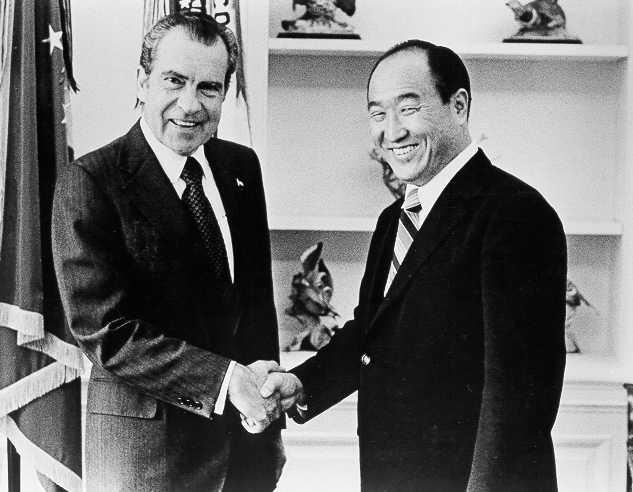
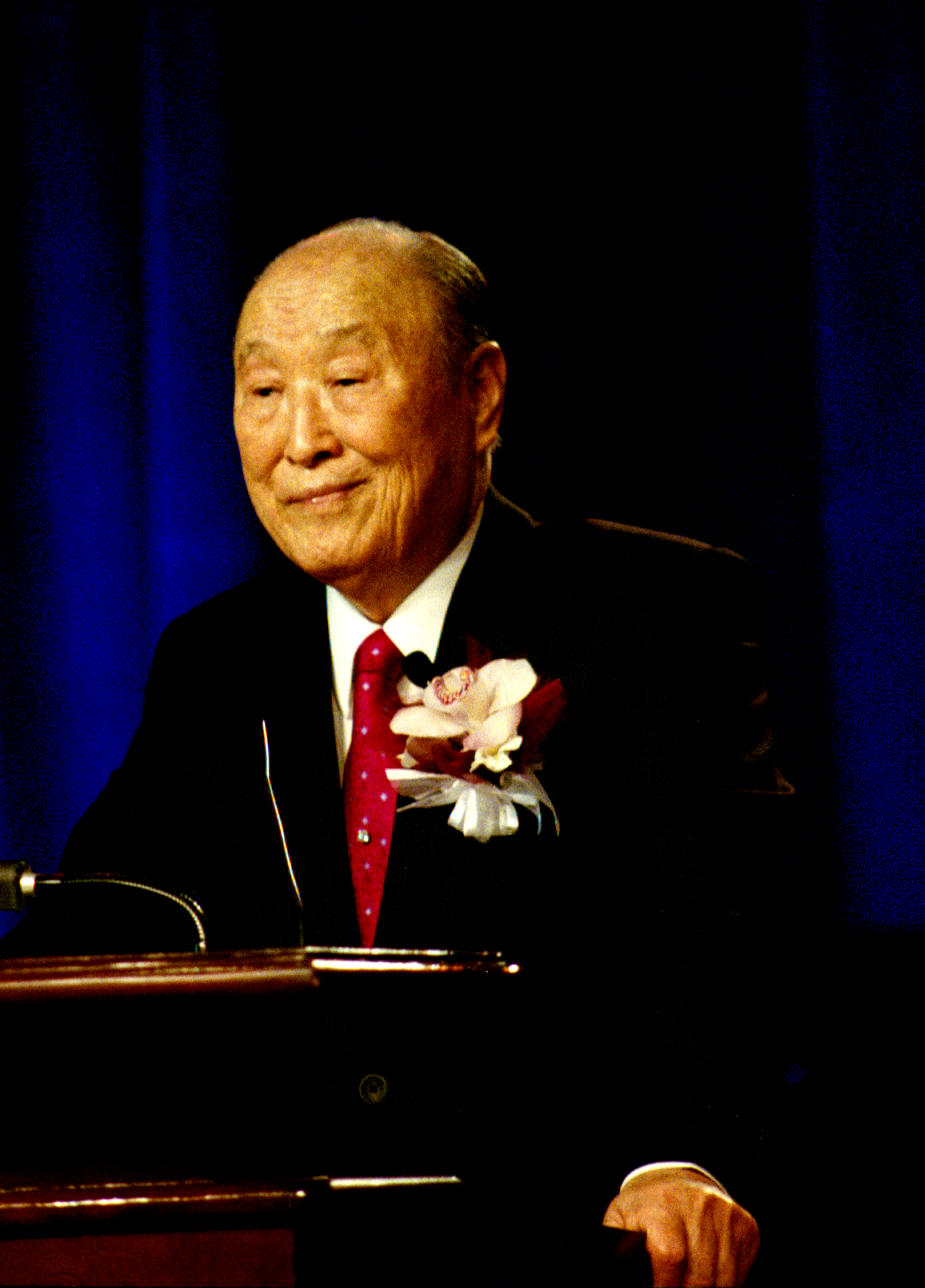
Moon first visited the United States in 1965 and permanently moved there in 1971, eventually settling in a 35-room mansion on an estate in Irvington, New York. He maintained his South Korean citizenship and residence there. In 1972, Moon founded the International Conference on the Unity of the Sciences (ICUS), a series of scientific conferences. The first conference had 20 participants, while the largest, held in Seoul in 1982, drew 808 participants from over 100 countries, including Nobel laureates like John Carew Eccles and Eugene Wigner. Newsweek selected him as Person of the Year for 1976.
In 1974, Moon instructed Unification Church members in the United States to support President Richard Nixon during the Watergate scandal. Church members prayed and fasted for Nixon for three days in front of the United States Capitol under the slogan "Forgive, Love and Unite." On 1 February 1974, Nixon publicly thanked them and officially received Moon, bringing the church widespread public and media attention. In the 1970s, Moon delivered a series of public speeches in the United States, Japan, and South Korea, with the largest being a 1975 rally against North Korean aggression in Seoul and a major event in Washington, D.C.
4.2. Global spread
The Unification Church expanded its reach internationally, establishing a presence in 194 countries. Moon's strategy focused on establishing Japan as an economic base to fund global missionary efforts. Early missionaries included Choi Bong-chun to Japan and Kim Young-woon and Kim Sang-cheol to the United States. Moon visited Japan in 1965, meeting with figures such as former Prime Minister Nobusuke Kishi and businessman Ryōichi Sasakawa. Within a few years of its founding, the Unification Church had established centers in France, Germany, Spain, and Italy. By 1965, Moon had traveled to 40 countries worldwide for missionary work, designating 120 holy sites. This global expansion was supported by the church's diverse commercial activities, which provided a significant economic foundation for its influence.
5. Business activities
Sun Myung Moon was extensively involved in business, establishing and managing numerous corporations and conglomerates across diverse sectors to support the Unification Church's mission.
5.1. Tongil Group
The Tongil Group (통일그룹Tongil GeurupKorean), meaning "unification" in Korean, is a South Korean business conglomerate (chaebol) founded by Moon in 1963 as a non-profit organization to generate revenue for the church. Initially focused on manufacturing, it expanded significantly in the 1970s and 1980s by founding or acquiring businesses in pharmaceuticals, tourism, and publishing. Key holdings of the Tongil Group include:
- The Ilhwa Company** (일화IlhwaKorean), which produces ginseng and related products.
- Ilshin Stone** (일신석재Ilshin SeokjaeKorean), specializing in building materials.
- Tongil Heavy Industries** (now SNT Heavy Industries), which manufactures machine parts, including hardware for the South Korean military.
5.2. News World Communications
News World Communications is an international news media corporation founded by Moon in 1976. Its most notable holding is The Washington Times, a conservative newspaper founded in 1982. The company also owns newspapers in South Korea (The Segye Ilbo), Japan (The Sekai Nippo), Latin America (Tiempos del Mundo), South Africa (The Zambezi Times), and Egypt (The Middle East Times), as well as the news agency United Press International (UPI). Until 2008, it published the Washington, D.C.-based newsmagazine Insight on the News. In 2010, Moon and a group of former Times editors repurchased the newspaper from News World Communications. The Washington Times was known for its conservative political views and was read by many Washington insiders, including President Ronald Reagan. By 2002, Moon had invested approximately 1.70 B USD to subsidize the Times, which he called "the instrument in spreading the truth about God to the world."
5.3. Other businesses
Moon's business interests extended beyond media and conglomerates into various other sectors:
- Seafood Industry:** The Unification Church is the largest owner of US sushi restaurants through True World Foods, which controls a major portion of the sushi trade in the US. The church's foray into the seafood industry began in 1976-1977 with an investment of nearly 1.00 M USD into the American seafood industry, following Moon's directive to expand into "the oceanic providence." In a 1980 sermon titled "The Way of Tuna," Moon claimed this business had "unlimited potential" and could generate "enough money to buy the entire world," declaring himself the "king of the ocean." He also suggested inter-national marriages to bypass fishing regulations. In 1986, he advised his followers to open a thousand restaurants in America. The church also owns Master Marine, a shipbuilding and fishing company in Alabama, and International Seafood of Kodiak, Alaska, which is the area's largest employer. In 2011, Master Marine opened a factory in Las Vegas to manufacture a 27-foot pleasure boat designed by Moon.
- Automotive Manufacturing:** The church founded Pyeonghwa Motors, the first currently operating automobile manufacturing plant in North Korea, contributing to inter-Korean exchange by selling cars like the Hwiparam. However, its operating rights were later transferred to North Korea.
- Hospitality and Resorts:** Construction of the 18.00 M USD Yeosu Expo Hotel was completed in 2011 at the Moon-owned Ocean Resort in Yeosu, the venue for Expo 2012. Another, the Ocean Hotel, was completed in February 2012. Moon-owned Yeongpyeong Resort, Ocean Resort, and Pineridge Resort were scheduled to host Expo 2012, the 2018 Winter Olympics, and Formula 1 events.
- Film Production:** In 1982, Moon sponsored the film Inchon, a historical drama about the Battle of Inchon during the Korean War. The film was a critical and financial failure and was criticized for its biased portrayal of the North Korean government.
- Sports Clubs:** In 1989, Moon founded Seongnam Ilhwa Chunma, which became the second most successful soccer club in South Korea, winning seven league titles, two FA Cups, three League Cups, and two AFC Champions League titles. He also acquired the Brazilian professional soccer team Sorocaba in São Paulo. After Moon's death, the Unification Church ceased its sports sponsorships, leading to the dissolution of the Chungnam Ilhwa Chunma women's soccer team and the acquisition of Seongnam Ilhwa Chunma by Seongnam City.
Moon also supported the Japan-Korea Undersea Tunnel project, stating in 2005 that he invested over 10.00 B JPY of Unification Church funds into it. This investment led to the purchase of approximately 4973 K ft2 (462.00 K m2) of land in Karatsu, Tsushima, and Iki in Japan for the project. Japanese sources indicate that Moon issued directives for significant financial transfers from Japan to Korea. For instance, in July 1975, he ordered monthly transfers of 2.00 B JPY from Japan, resulting in an estimated 200.00 B JPY over about 10 years from 1975 and approximately 490.00 B JPY over nine years from 1999. These funds, collected through what critics call "spiritual sales" (霊感商法, reikan shōhō) and other controversial business practices in Japan, were used to support Unification Church activities in the United States and South Korea.
6. Political activities and influence
Sun Myung Moon's political engagement was deeply rooted in his anti-communist ideology, fostering relationships with global leaders and wielding significant influence, particularly within conservative political circles.
6.1. Anti-communism and political participation
Moon held a strong anti-communist stance, viewing the Cold War as the ultimate conflict between God and Satan, with divided Korea as the primary front line. He used the term 'Seung-gong' (victory over communism) rather than 'Ban-gong' (anti-communism) or 'Myeol-gong' (eradication of communism), emphasizing overcoming communism rather than mere opposition. In 1964, he founded the Korean Culture and Freedom Foundation, which promoted South Korean interests and sponsored Radio Free Asia. Former US Presidents Harry S. Truman, Dwight D. Eisenhower, and Richard Nixon served as honorary presidents or directors at various times.
In 1972, Moon predicted the decline of communism based on the Divine Principle, stating that communism, which began in 1917, would peak around 1978 and be "altogether ruined" by its 70th year. In 1980, Moon established CAUSA International in New York City as an anti-communist educational organization, which was active in 21 countries by the 1980s. CAUSA sponsored educational conferences for Christian leaders and seminars for Senate staffers and conservative activists in the United States. It also produced the anti-communist documentary film Nicaragua Was Our Home (1986) and supported the Contras in Nicaragua.
In August 1985, the Professors World Peace Academy, another Moon-founded organization, hosted a conference in Geneva to discuss the post-communist world. After the dissolution of the Soviet Union in 1991, some American conservatives criticized Moon for what they perceived as a softening of his anti-communist stance. Moon's anti-communist activities also received financial support from controversial Japanese millionaire and activist Ryōichi Sasakawa. In 2003, Unification Church members in South Korea founded "The Party for God, Peace, Unification, and Home," a political party aimed at preparing for Korean reunification by educating the public about God and peace. The party also established a branch in Nepal, winning one seat in its national elections. Moon was also a member of the Honorary Committee of the Unification Ministry of the Republic of Korea.
6.2. Relations with world leaders
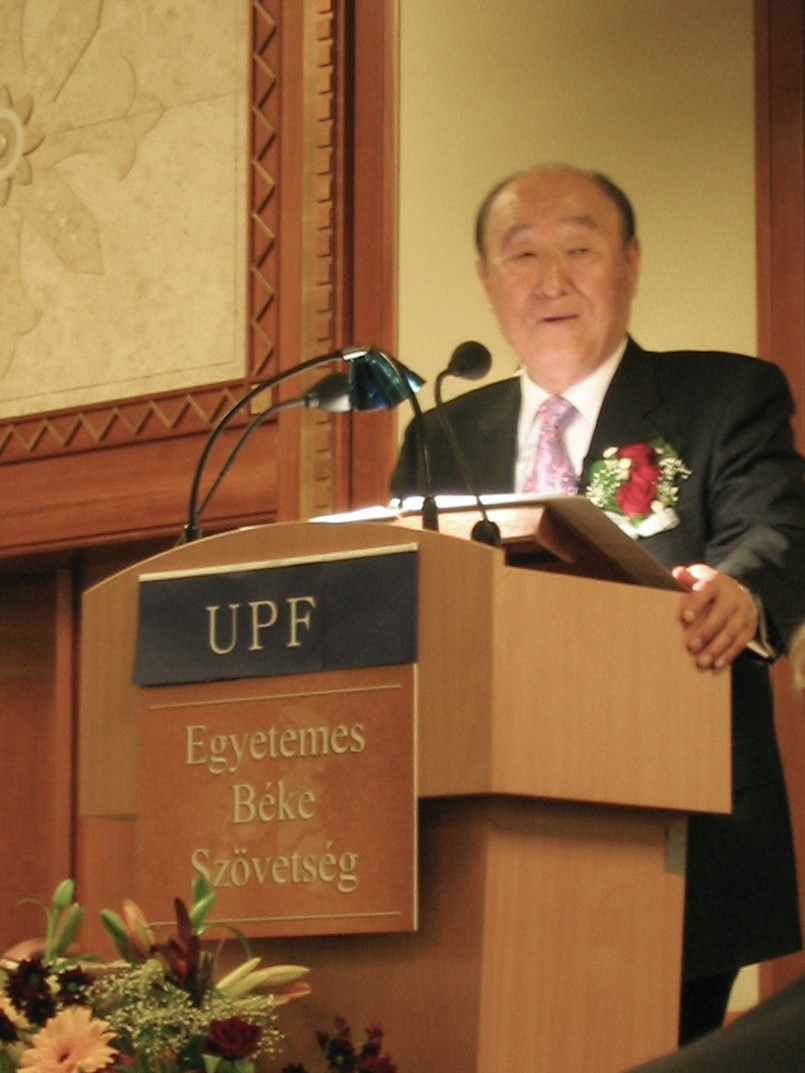
Moon engaged with prominent political figures worldwide. In April 1990, he visited the Soviet Union and met President Mikhail Gorbachev, expressing support for the political and economic transformations there, coinciding with the Unification Church's expansion into formerly communist nations.
In December 1991, Moon made an unannounced visit to North Korea, arranged by the Chinese government, to meet with then-North Korean President Kim Il Sung in Pyongyang and visit his hometown, Jeongju. Despite the lack of diplomatic relations between North and South Korea, Moon was officially invited to Kim Il Sung's funeral in 1994. During their meeting, they discussed achieving peace on the Korean peninsula, international relations, tourism, and agreed on issues such as reuniting separated families, accepting nuclear inspections, allowing investments from free-world nations, and the Unification Group's participation in economic projects excluding military industries. Moon stated that his "victory-over-communism thought is not a thought to kill communists, but a thought to save them, that is, a thought for the salvation of humanity." After Moon's death, North Korean leader Kim Jong Un expressed condolences to Hak Ja Han and the family in 2013, praying for Moon who "worked hard for national concord, prosperity and reunification and world peace." Moon was posthumously awarded North Korea's National Reunification Prize in 2012.
Moon also cultivated relationships with US Presidents Richard Nixon, George H. W. Bush, and George W. Bush. He was criticized for his support of controversial figures such as Nation of Islam leader Louis Farrakhan. In 2000, Moon sponsored a United Nations conference that proposed the formation of "a religious assembly, or council of religious representatives, within the structure of the United Nations." In 2005, Moon and Hak Ja Han founded the Universal Peace Federation (UPF), an NGO in Special Consultative Status with the United Nations Economic and Social Council, which supports the work of the United Nations and the achievement of the Sustainable Development Goals. Moon's projects were lobbied in the National Congress of Brazil by Brazilian MPs, and he held dialogues between members of the Israeli Knesset and the Palestinian Parliament as part of his Middle East Peace Initiatives. In 2013, Zimbabwean Prime Minister Morgan Tsvangirai praised Moon's work. More recently, in 2021, former US President Donald Trump praised Moon at a Unification Church-linked event, and other Trump administration figures like Mike Pence and Mike Pompeo had spoken at "Rally of Hope" events organized by the church.
6.3. Support for Korean unification
Moon and the Unification Church were well-known for their efforts to promote Korean unification. In 1991, Moon met with North Korean President Kim Il Sung to discuss ways to achieve peace on the Korean peninsula, leading to agreements on family reunions, nuclear inspections, and economic cooperation. In 2003, Unification Church members in South Korea established a political party, "The Party for God, Peace, Unification, and Home," focused on educating the public about God and peace to prepare for reunification. Moon was an honorary member of the Ministry of Unification of the Republic of Korea. After his death, he was posthumously awarded North Korea's National Reunification Prize.
6.4. Influence on conservative politics
Moon and his organizations exerted significant influence within conservative political circles globally, providing financial support and media backing, notably through The Washington Times. This influence drew criticism regarding the separation of church and state.
In February 1988, Moon expressed displeasure with former Prime Minister Yasuhiro Nakasone's decision to designate Noboru Takeshita as the next party president, stating that if Takeshita had not been pushed, Shintaro Abe would have become prime minister. In Japan, Moon actively sought to strengthen ties with Japanese politicians, particularly targeting the Abe faction of the Liberal Democratic Party. In July 1989, he instructed followers in Korea to focus on building relationships with Japanese Diet members, stating his intention to "create a church within the Diet" and "produce secretaries for Diet members" from the Unification Church. He claimed that through educating Diet members with the Divine Principle, "everything would become possible." He also aimed to expand this influence to local politics. In October 2006, shortly after Shinzo Abe became Prime Minister, Moon instructed followers to meet with Abe's chief of staff.
Moon's autobiography, As a Peace-Loving Global Citizen, published in 2009, became a bestseller in Korea and Japan.
7. Legal issues and controversies
Sun Myung Moon and the Unification Church faced numerous legal challenges and controversies throughout their history, including convictions for tax evasion, widespread criticism of their doctrines and practices, and internal family disputes.
7.1. Tax evasion conviction
In 1982, following an IRS investigation, Moon was convicted in the United States on charges of conspiracy and willfully filing false federal income tax returns, involving less than 8.00 K USD. He refused to remain in Korea and returned to the United States. His conviction was upheld on appeal in a split decision. Moon was sentenced to 18 months in federal prison and a 15.00 K USD fine. He served 13 months at the Federal Correctional Institution, Danbury, before being released to a halfway house on good behavior.
The case sparked national debates on freedom of religion and freedom of speech. Critics argued that the trial was biased against him due to religious prejudice. Legal scholars like Professor Laurence H. Tribe of Harvard University Law School contended that the jury trial "doomed (Moon) to conviction based on religious prejudice." Various religious organizations, including the American Baptist Churches USA, the National Council of Churches, the National Black Catholic Clergy Caucus, and the Southern Christian Leadership Conference, filed briefs supporting Moon. Notable clergy, including Jerry Falwell and Joseph Lowery, signed petitions and spoke out in his defense, viewing his conviction as a humiliation of religious liberty.
7.2. Criticism of doctrines and practices
Moon's claim to be the Messiah and the Second Coming of Christ has been widely rejected by both Jewish and Christian scholars. The Divine Principle was labeled as heresy by Protestant churches in South Korea, including Moon's own Presbyterian Church, and was deemed non-Christian by ecumenical organizations in the United States. Critics argued that Unificationism diverged from mainstream Christianity by being unbiblical, teaching erroneous doctrines of God, Christ, and salvation, and asserting that the Divine Principle usurped the status of the Judeo-Christian Bible. Protestant commentators also criticized Moon's teachings for contradicting the doctrine of salvation by faith alone. Theologians like Walter Ralston Martin and Ravi K. Zacharias disagreed with the Divine Principle on issues such as the divinity of Christ, the virgin birth of Jesus, Moon's belief that Jesus should have married, the necessity of the crucifixion of Jesus, and a literal resurrection of Jesus and second coming of Jesus. While the church claimed millions of followers, some critics asserted the number was closer to 100,000.
Commentators also criticized the Divine Principle's assertion that World War I, World War II, the Holocaust, and the Cold War served as "indemnity conditions" to prepare the world for the establishment of the Kingdom of God.
The Unification Church has faced allegations of religious fraud, brainwashing, and financial impropriety. Critics, including former members and anti-cult activists, claimed that Moon exerted strong ideological control and behavioral modification over his followers, turning them into "slaves" of the organization. The church's practice of "spiritual sales" (霊感商法, reikan shōhō) in Japan, involving the sale of expensive religious artifacts, became a significant social issue in the 1980s.
7.3. Controversial statements and actions
Moon made several controversial statements and engaged in actions that drew public criticism:
- Homosexuality:** Moon strongly opposed homosexuality, comparing gay people to "dirty dung-eating dogs" and stating that "gays will be eliminated" in a "purge on God's orders."
- Holocaust:** In 2003, Moon sparked controversy by asserting that the Holocaust was a price paid for the Jewish people's failure to support Jesus.
- Anti-Japanese Sentiments:** In his collected speeches, Moon Seon-myeong Malssum Seonjip (문선명선생말씀선집Mun Seon-myeong Seonsaeng Malssum SeonjipKorean), Moon expressed intense animosity towards Japan, referring to Japanese people with the derogatory term "倭奴" (왜놈WaenomKorean, "Japanese slave"). He claimed to have considered assassinating Emperor Hirohito and destroying the Nijūbashi bridge at the Tokyo Imperial Palace during his time studying in Japan. He also advanced Korean origin theories, such as claiming that Amaterasu Omikami, the Japanese sun goddess, had Korean roots, and that historical figures like Saigō Takamori were Korean. He also asserted Korean ownership of Tsushima Island.
- Political Infiltration:** In his speeches, Moon explicitly outlined strategies for political infiltration, stating that his organization had penetrated all levels of Japanese politics, including the Liberal Democratic Party, opposition parties, and even the Japan Self-Defense Forces. He claimed that information from the deepest layers of the Japanese Communist Party was being reported to him, making it impossible for the Cabinet Intelligence and Research Office or public security agencies to intervene.
- Support for Controversial Figures:** Moon was criticized for his support of controversial figures such as Nation of Islam leader Louis Farrakhan and his sponsorship of the Million Family March in 2000. He was also criticized for his relationship with controversial Jewish scholar Richard L. Rubenstein, an advocate of the "death of God theology" of the 1960s, who defended the Unification Church and served on its advisory council and the board of directors of The Washington Times.
- Conflict with Catholic Church:** In 2001, Moon came into conflict with the Roman Catholic Church when he and his wife presided over a blessing ceremony for 71-year-old Catholic archbishop Emmanuel Milingo and a 43-year-old Korean acupuncturist, Maria Sung. This led to Milingo's excommunication and a public dispute with the Vatican.
7.4. Family and succession controversies
Controversies also surrounded Moon's family life, including allegations of neglect and internal disputes among his children regarding succession within the movement's leadership. After Moon's death, his children became embroiled in a "princes' rebellion," with various siblings vying for control and diverging on the movement's future. This included Moon Hyo Jin's struggles with addiction and domestic violence, Moon Hyun Jin's departure to form his own organization due to doctrinal differences, and Moon Young Jin's suicide.
9. Death and legacy
Sun Myung Moon's final years were marked by declining health, leading to his death in 2012. His legacy continues through the Unification Church, led by his wife, and through various commemorative projects.
9.1. Later years and death
In his later years, Moon continued to maintain an active schedule, including opening the Peace Cup in July 2012 and visiting his alma mater, Osan High School, in August 2012. However, his health rapidly deteriorated. On 14 August 2012, after suffering from pneumonia earlier in the month, Moon was admitted to Saint Mary's Hospital at The Catholic University of Korea in Seoul. He was reported to be gravely ill and placed on a ventilator in the intensive care unit. On 31 August 2012, after being diagnosed with irreversible multiple organ failure, Moon was transferred to a church-owned hospital near his home in Gapyeong County, northeast of Seoul. Moon died on the morning of 3 September 2012, at the age of 92.
In July 2008, Moon, his family, and followers were involved in a helicopter crash near Jangrak Mountain in Gapyeong, South Korea. The US Sikorsky S-92 helicopter, similar to the US presidential helicopter, crashed during bad weather while returning from a meeting in Seoul. All 16 occupants, including Moon and his family, safely evacuated before the helicopter exploded and burned. Most sustained only minor injuries, with three suffering moderate to severe injuries.
In 2010, on Moon's 90th birthday, he received congratulations from various international figures, including US President Barack Obama and North Korean leader Kim Jong Il. Kim Jong Il sent three wild ginseng roots, an embroidered ribbon with a congratulatory message, and a vase with 90 roses and 90 lilies through Park Sang-kwon, president of Pyeonghwa Motors.
9.2. Legacy and commemorative projects
Following Moon's death, his wife, Hak Ja Han, assumed central leadership as the co-president of the Family Federation for World Peace and Unification (formerly the Unification Church), continuing his work. Commemorative projects were established in his honor, including the Sunhak Peace Prize, proposed several months after his death. The prize, inheriting Moon's vision, recognizes and empowers innovations in human development, conflict resolution, and ecological conservation, awarding laureates with a certificate, a medal, and 1.00 M USD.
Moon was posthumously awarded North Korea's National Reunification Prize in 2012 and a meritorious award by the K League. On the first anniversary of Moon's death in 2013, North Korean leader Kim Jong Un expressed condolences to Hak Ja Han and the family, acknowledging Moon's efforts for "national concord, prosperity and reunification and world peace." In 2021, former US President Donald Trump praised Moon at an event linked to the Unification Church, following previous "Rally of Hope" events that featured prominent figures from the Trump administration.
10. Evaluation and impact
Sun Myung Moon's life and work evoke diverse perspectives, ranging from profound reverence among his followers to strong criticism from scholars and former members, leaving a complex and often controversial social and historical impact.
10.1. Followers' views
Followers of Sun Myung Moon generally view him with deep reverence, often considering him to be the Messiah, the Second Coming of Christ, and the "True Parent" of humanity. They believe he was sent by God to complete Jesus' unfinished mission and to establish God's ideal family on Earth. His teachings, as outlined in the Divine Principle, are seen as a comprehensive framework for understanding human suffering and the path to spiritual restoration. Followers often emphasize his personal sacrifices and suffering, including his imprisonments, as a testament to his devotion to humanity's salvation. They perceive his leadership as charismatic, providing a model of valiant suffering, confident knowledge, assured prayer, and loving life. Many converts, even those with minimal personal contact with Moon, found his explanation of the universe to resonate deeply with their own understanding, experiencing his truth as their own. Sociologist Irving Louis Horowitz observed that Moon's belief system offered an "all-embracing truth" and a "holistic concern for the person, society, nature, and all things embraced by the human vision," appealing to those seeking unity in a complex world.
10.2. Critical views
Critics, including scholars, former members, and media outlets, have raised significant concerns about Sun Myung Moon and the Unification Church. His messianic claims have been rejected by both Jewish and Christian scholars, and the Divine Principle has been labeled as heresy by mainstream Protestant churches for its theological divergences, such as its views on the divinity of Christ, the virgin birth, Jesus' marriage, and the necessity of the crucifixion and literal resurrection. While the church claimed millions of followers, some critics asserted the number was closer to 100,000.
Allegations of religious fraud, brainwashing, and financial impropriety have been prominent criticisms. Former members and anti-cult movements accused the church of exerting strong thought control and behavioral modification, leading to a loss of individual autonomy. The practice of "spiritual sales" in Japan, which generated significant wealth for the church, was a major source of controversy.
Moon's political activities also drew criticism, particularly his anti-communist stance during the Cold War, which some feared could lead to global conflict. His relationships with political leaders and his influence on conservative politics were scrutinized as potential violations of the separation of church and state. Specific controversial statements, such as his condemnation of homosexuality and his views on the Holocaust, have also been widely condemned. His alleged neglect of his children and the internal family disputes regarding succession further contributed to critical views.
10.3. Social and historical impact
Sun Myung Moon's life and work had a significant and often controversial impact on global religious movements, international politics, business, and society. He founded a new religious movement that expanded worldwide, attracting millions of followers and establishing a global presence. His emphasis on family values and his signature mass wedding ceremonies garnered widespread attention, influencing discussions on marriage and interfaith relations.
In the business sphere, Moon built a vast empire spanning various industries, from manufacturing and media to seafood and hospitality, providing a substantial economic foundation for his religious and political endeavors. His establishment of media outlets like The Washington Times gave him a platform to influence conservative political discourse.
Politically, Moon was a staunch anti-communist who engaged in extensive lobbying and formed relationships with world leaders, from US presidents to Soviet and North Korean leaders. His efforts towards Korean unification, including meetings with Kim Il Sung, were notable, though often controversial. However, his strong influence on conservative politics, particularly in countries like Japan, raised concerns about the blurring lines between religious organizations and political power.
Overall, Moon's legacy is a complex tapestry of spiritual leadership, entrepreneurial ambition, and political activism, marked by both profound devotion and persistent criticism regarding his doctrines, practices, and impact on individuals and democratic institutions.